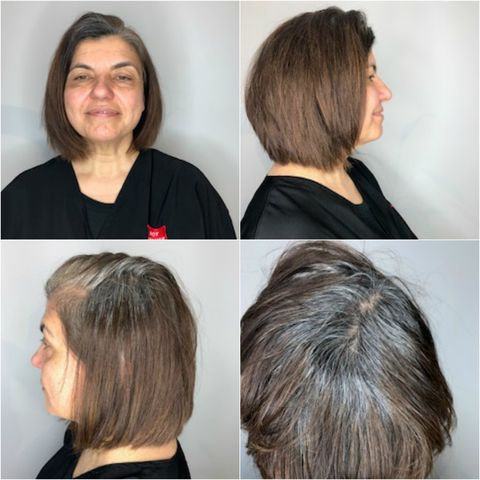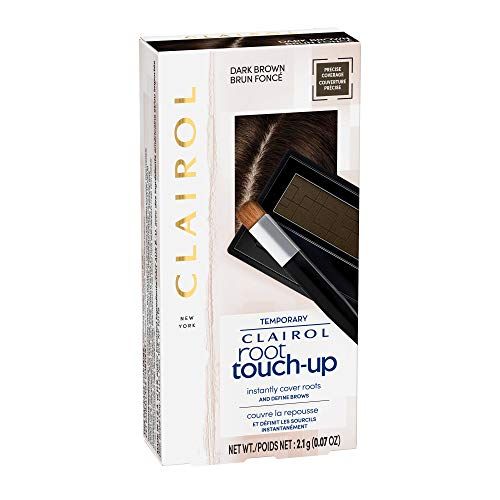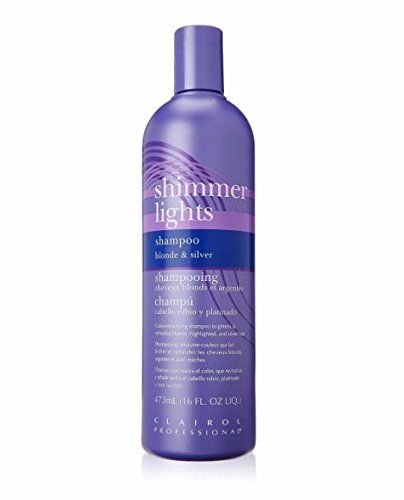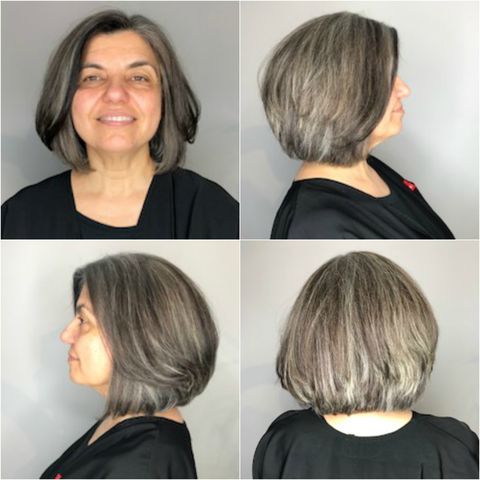Like most things in life, going gray is a gradual process, starting with a few silver strands peeking out from your natural or dyed hair color, often increasing in number over time. When more of your hair starts growing in gray, you may start to notice a demarcation line in larger sections where the color stopped and the gray started. As this occurs, you have options: covering it with salon or home hair dye or embracing the natural gray hue.
In the case of Good Housekeeping Institute Beauty, Health and Sustainability Lab Director Birnur Aral, Ph.D., she did a little bit of both. “I had an unrelated allergic reaction that made my lips swell up for a few weeks, so I skipped my monthly hair color visit in order to give my body a break,” explains Aral, who had been coloring her hair since her late 20s to cover up grays. “My roots grew about an inch, and I started noticing the salt-and-pepper pattern of my natural hair and toying with the idea of going gray.”
There’s no hard-and-fast rule about when (or if!) you should stop coloring your hair and go gray; it’s ultimately a personal choice. When Aral did decide to go fully gray, her experience both personally and professionally — this scientist has tested a whole lot of hair dye in her years at the GH Institute! — can serve as a guide for you if you’re ready to make the switch.
More From Good Housekeeping
Here are the tips you need to know about the stages of transitioning to gray hair both in the salon and naturally, including the best products, pictures of the process and gorgeous gray hairstyles.
First, let your roots grow in a bit
Even if you feel ready to go gray, you may have to wait before you begin the process. “I tell people to get at least two inches of gray growth to begin with,” says Nikki Ferrara, a celebrity hair colorist in NYC.
Be patient with the process.
If you’ve never lightened your hair before, you could find yourself in the salon for an unexpected length of time during the gray transitioning coloring process. “I spent a total of seven hours in the salon and really saw how intensive the process was,” Aral explains.
Aside from the time investment of a salon session, there’s how long it takes to fully transition to gray hair, which is anywhere from six months to a year, Ferrara says. “Some people won’t have the patience, so they choose to color their hair again,” she notes. “But it’s super-rewarding if you can stick it out.”
Option 1: Try weaving in highlights or lowlights.
Streaks of strategic color help meld your existing shade with the growing in gray. “To match the salt-and-pepper look of my roots, the colorist added baby highlights [thin, subtle highlights] all over my head,” Aral says. “Toward the end of the lifting process, the colorist applied dark brown hair color to the remaining hair to create an all-over salt-and-pepper effect,” says Aral; this process is referred to as adding lowlights, which are darker ribbons of color, woven in to blend. Depending on the color you’re transitioning away from (lighter brown, red, blonde, black) your experience may be different.
Option 2: Consider removing old hair dye from natural gray strands.
You can remove dyed hair color to go fully gray. “Removing hair color can be done at home or in a salon by using hair stripping products that work by opening the cuticles [hair’s outer layer] and breaking down dye molecules inside the cortex so they can be rinsed out,” she explains. “Since hair stripping products interact with dyes only, the natural pigments in hair stay intact, allowing your gray color to appear.” (Note that “returning to a natural gray color is not possible if your hair was bleached and its pigments lightened,” says GH Beauty Lab Senior Chemist Sabina Wizemann, who recently let her gray grow in.
Option 3: Dye hair fully gray.
An at-home option for making the switch to full natural silver is dyeing hair gray. “There is now at-home hair color available in silver and gray shades that can dye pigmented hair gray and make the transition faster and easier,” says Wizemann.
Option 4: Let hair go gray naturally.
If you decide to grow out your grays without additional salon or at-home hair color, Aral suggests covering up the new growth with a root touch-up product, like GH Beauty Award winner Clairol Temporary Root Touch-Up. “Depending on the person’s gray level and hair color, they might be able to blend in [their] roots for five to six weeks, or longer,” she says.
From there, Aral recommends considering a shorter haircut and getting regular trims until it grows out. Keep in mind, though, that using any hair dye that’s not temporary will set back your growing out phase, so avoid all-over permanent and demi or semi-permanent hair color.
Adjust your haircare maintenance accordingly.
As with going platinum or any cooler blonde shade, you may find that the gray “highlights” get a little brassy. “The highlighted parts turn a bit yellow once the gray toner starts washing out,” Aral said. Your colorist may recommend coming in for more toner or glosses during the course of your transition to counteract yellowing. “Usually, you will have to get a gloss every once in a while to keep the brassiness at bay,” Ferrara says. You can try an at-home toning hair gloss or glaze to keep your gray a gorgeous silver shade between salon visits.
You may also have to adapt your shampooing and conditioning routine: “My gray is a bit wirier, so I now use more conditioner than I’m used to and a purple shampoo/conditioner duo once a week to brighten it up,” Wizemann says. “I also use more styling products to keep my hair in place.” There are shampoos designed specifically for gray, white or silver hair you can use to keep hair vibrant, and you can consider adding in a hydrating, deep conditioning hair mask to keep coarse grays soft and shiny.
Now that you’ve got the gray hair transitioning basics down, check out the style inspiration below:
Marci Robin is a freelance writer and editor specializing in beauty and lifestyle content. With over 20 years of experience, Marci has served as a contributing editor for Allure, senior beauty editor at GoodHousekeeping.com, executive editor of xoVain and senior online editor at NewBeauty. Her writing has also appeared in her writing has also appeared in InStyle, MarthaStewart.com and Refinery29.
April (she/her) is the beauty director at Good Housekeeping, Prevention and Woman’s Day, where she oversees all beauty content. She has over 15 years of experience under her belt, starting her career as an assistant beauty editor at GH in 2007, and working in the beauty departments of SELF and Fitness magazines.
This content is imported from OpenWeb. You may be able to find the same content in another format, or you may be able to find more information, at their web site.







